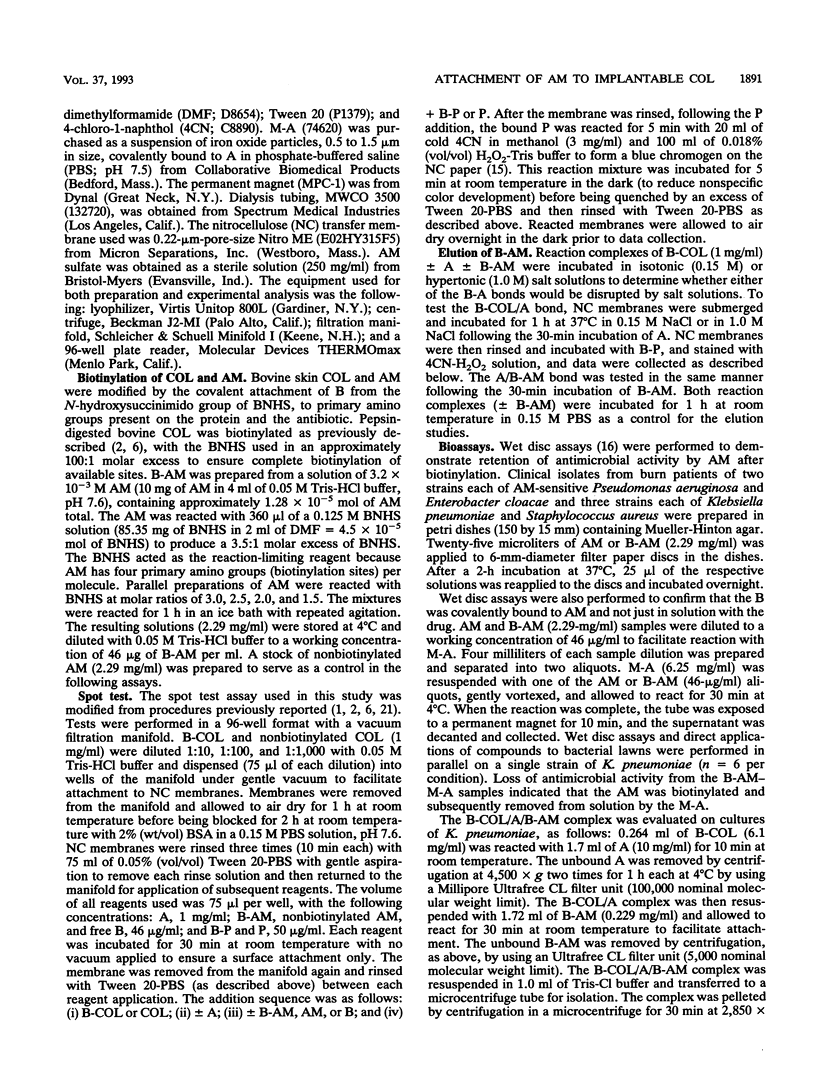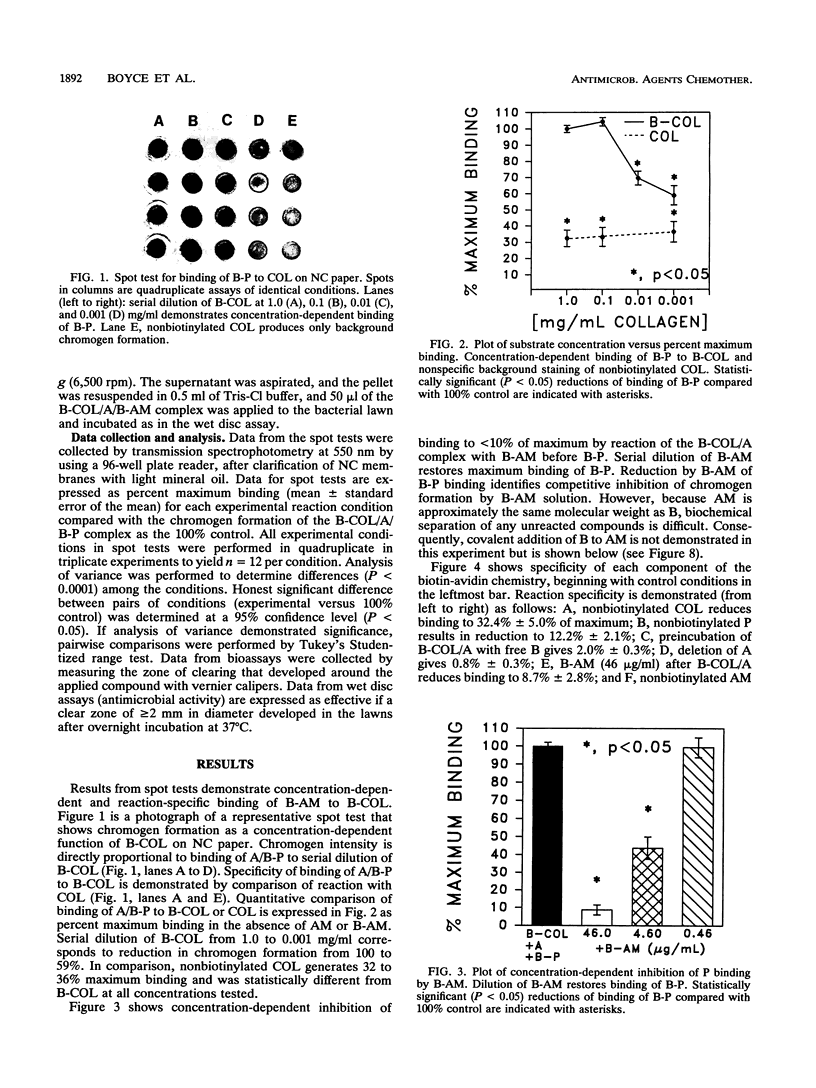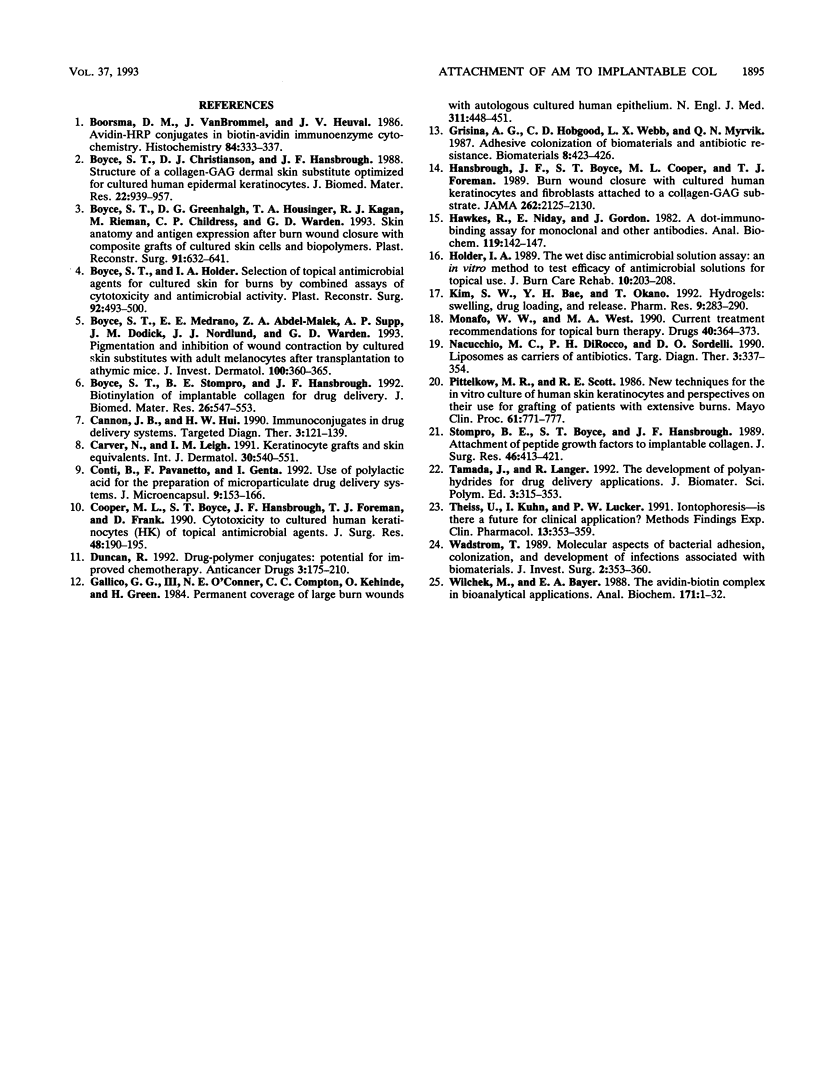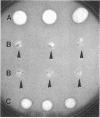Abstract
Cultured skin substitutes consisting of implantable collagen (COL) and cultured human skin cells often fail clinically from destruction by microbial contamination. Hypothetically, addition of selected antimicrobial drugs to the implant may control microbial contamination and increase healing of skin wounds with these materials. As a model for drug delivery, bovine skin COL (1 mg/ml) and amikacin (AM; 46 micrograms/ml) were modified by covalent addition of biotin (B-COL and B-AM, respectively) from B-N-hydroxysuccinimide and bound together noncovalently with avidin (A). B-COL was incubated with A and then with B-peroxidase (B-P) or by serial incubation with B-AM and B-P, before P-dependent chromogen formation. Colorimetric data (n = 12 per condition) from spot tests on nitrocellulose paper were collected by transmission spectrophotometry. Specificity of drug binding in spot tests was determined by (i) serial dilution of B-COL; (ii) reactions with COL, AM, or P that had no B; (iii) removal of A; or (iv) preincubation of B-COL-A with B before incubation with B-P. Binding of B-AM was (i) dependent on the concentration of B-COL; (ii) specific to B-COL, A, and B-P (P < 0.05); and (iii) not eluted by incubation in 0.15 or 1.0 M NaCl. B-AM was found to block binding of B-P to the B-COL-A complex and to retain bacteriocidal activity against 10 clinical isolates of wound bacteria in the wet disc assay. Antimicrobial activity of B-AM was removed from solution by treatment with magnetic A and a permanent magnet. These results suggest that selected antimicrobial drugs can be biotinylated for attachments to COL-cultured cell implants without loss of pharmacologic activity. Because this chemistry utilizes a common ligand, any molar ratio of agents may be administered simultaneously and localized to the site of implantation.
Full text
PDF





Images in this article
Selected References
These references are in PubMed. This may not be the complete list of references from this article.
- Boorsma D. M., Van Bommel J., Vanden Heuvel J. Avidin-HRP conjugates in biotin-avidin immunoenzyme cytochemistry. Histochemistry. 1986;84(4-6):333–337. doi: 10.1007/BF00482959. [DOI] [PubMed] [Google Scholar]
- Boyce S. T., Christianson D. J., Hansbrough J. F. Structure of a collagen-GAG dermal skin substitute optimized for cultured human epidermal keratinocytes. J Biomed Mater Res. 1988 Oct;22(10):939–957. doi: 10.1002/jbm.820221008. [DOI] [PubMed] [Google Scholar]
- Boyce S. T., Greenhalgh D. G., Kagan R. J., Housinger T., Sorrell J. M., Childress C. P., Rieman M., Warden G. D. Skin anatomy and antigen expression after burn wound closure with composite grafts of cultured skin cells and biopolymers. Plast Reconstr Surg. 1993 Apr;91(4):632–641. doi: 10.1097/00006534-199304000-00010. [DOI] [PubMed] [Google Scholar]
- Boyce S. T., Medrano E. E., Abdel-Malek Z., Supp A. P., Dodick J. M., Nordlund J. J., Warden G. D. Pigmentation and inhibition of wound contraction by cultured skin substitutes with adult melanocytes after transplantation to athymic mice. J Invest Dermatol. 1993 Apr;100(4):360–365. doi: 10.1111/1523-1747.ep12471822. [DOI] [PubMed] [Google Scholar]
- Boyce S. T., Stompro B. E., Hansbrough J. F. Biotinylation of implantable collagen for drug delivery. J Biomed Mater Res. 1992 Apr;26(4):547–553. doi: 10.1002/jbm.820260410. [DOI] [PubMed] [Google Scholar]
- Cannon J. B., Hui H. W. Immunoconjugates in drug delivery systems. Targeted Diagn Ther. 1990;3:121–139. [PubMed] [Google Scholar]
- Carver N., Leigh I. M. Keratinocyte grafts and skin equivalents. Int J Dermatol. 1991 Aug;30(8):540–551. doi: 10.1111/j.1365-4362.1991.tb02636.x. [DOI] [PubMed] [Google Scholar]
- Conti B., Pavanetto F., Genta I. Use of polylactic acid for the preparation of microparticulate drug delivery systems. J Microencapsul. 1992 Apr-Jun;9(2):153–166. doi: 10.3109/02652049109021231. [DOI] [PubMed] [Google Scholar]
- Cooper M. L., Boyce S. T., Hansbrough J. F., Foreman T. J., Frank D. H. Cytotoxicity to cultured human keratinocytes of topical antimicrobial agents. J Surg Res. 1990 Mar;48(3):190–195. doi: 10.1016/0022-4804(90)90212-k. [DOI] [PubMed] [Google Scholar]
- Duncan R. Drug-polymer conjugates: potential for improved chemotherapy. Anticancer Drugs. 1992 Jun;3(3):175–210. doi: 10.1097/00001813-199206000-00001. [DOI] [PubMed] [Google Scholar]
- Gallico G. G., 3rd, O'Connor N. E., Compton C. C., Kehinde O., Green H. Permanent coverage of large burn wounds with autologous cultured human epithelium. N Engl J Med. 1984 Aug 16;311(7):448–451. doi: 10.1056/NEJM198408163110706. [DOI] [PubMed] [Google Scholar]
- Gristina A. G., Hobgood C. D., Webb L. X., Myrvik Q. N. Adhesive colonization of biomaterials and antibiotic resistance. Biomaterials. 1987 Nov;8(6):423–426. doi: 10.1016/0142-9612(87)90077-9. [DOI] [PubMed] [Google Scholar]
- Hansbrough J. F., Boyce S. T., Cooper M. L., Foreman T. J. Burn wound closure with cultured autologous keratinocytes and fibroblasts attached to a collagen-glycosaminoglycan substrate. JAMA. 1989 Oct 20;262(15):2125–2130. [PubMed] [Google Scholar]
- Hawkes R., Niday E., Gordon J. A dot-immunobinding assay for monoclonal and other antibodies. Anal Biochem. 1982 Jan 1;119(1):142–147. doi: 10.1016/0003-2697(82)90677-7. [DOI] [PubMed] [Google Scholar]
- Holder I. A. The wet disc antimicrobial solution assay. An in vitro method to test efficacy of antimicrobial solutions for topical use. J Burn Care Rehabil. 1989 May-Jun;10(3):203–208. [PubMed] [Google Scholar]
- Kim S. W., Bae Y. H., Okano T. Hydrogels: swelling, drug loading, and release. Pharm Res. 1992 Mar;9(3):283–290. doi: 10.1023/a:1015887213431. [DOI] [PubMed] [Google Scholar]
- Monafo W. W., West M. A. Current treatment recommendations for topical burn therapy. Drugs. 1990 Sep;40(3):364–373. doi: 10.2165/00003495-199040030-00004. [DOI] [PubMed] [Google Scholar]
- Nacucchio M. C., Di Rocco P. H., Sordelli D. O. Liposomes as carriers for antibiotics. Targeted Diagn Ther. 1990;3:337–354. [PubMed] [Google Scholar]
- Pittelkow M. R., Scott R. E. New techniques for the in vitro culture of human skin keratinocytes and perspectives on their use for grafting of patients with extensive burns. Mayo Clin Proc. 1986 Oct;61(10):771–777. doi: 10.1016/s0025-6196(12)64815-0. [DOI] [PubMed] [Google Scholar]
- Stompro B. E., Hansbrough J. F., Boyce S. T. Attachment of peptide growth factors to implantable collagen. J Surg Res. 1989 May;46(5):413–421. doi: 10.1016/0022-4804(89)90153-4. [DOI] [PubMed] [Google Scholar]
- Tamada J., Langer R. The development of polyanhydrides for drug delivery applications. J Biomater Sci Polym Ed. 1992;3(4):315–353. doi: 10.1163/156856292x00402. [DOI] [PubMed] [Google Scholar]
- Theiss U., Kuhn I., Lücker P. W. Iontophoresis--is there a future for clinical application? Methods Find Exp Clin Pharmacol. 1991 Jun;13(5):353–359. [PubMed] [Google Scholar]
- Wadström T. Molecular aspects of bacterial adhesion, colonization, and development of infections associated with biomaterials. J Invest Surg. 1989;2(4):353–360. doi: 10.3109/08941938909018261. [DOI] [PubMed] [Google Scholar]
- Wilchek M., Bayer E. A. The avidin-biotin complex in bioanalytical applications. Anal Biochem. 1988 May 15;171(1):1–32. doi: 10.1016/0003-2697(88)90120-0. [DOI] [PubMed] [Google Scholar]




